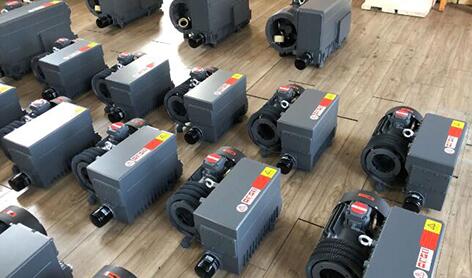Rotary vane vacuum pump of EPVC production line
EPVC manufacturers choose the rotary vane vacuum pump. The reason why they choose the application of rotary vane vacuum pump in EPVC production is closely related to the working principle and structural characteristics of the rotary vane vacuum pump. Therefore, EVP vacuum pump manufacturers analyze the advantages of the rotary vane vacuum pump products based on this application to enable manufacturers to choose it.
What is EPVC.
EPVC is paste PVC resin. The appearance of EPVC paste resin is white powder, with an average polymerization degree of 1150-1350, (k) value of 67-72, Brinell viscosity of 2500-3500, fineness of 250 mesh, and volatile (moisture) content of 0.5%. EPVC is made by emulsion polymerization and has a small particle size. In the domestic plastics industry, the product is widely used in artificial leather, flame retardant conveyor belt, plastic coated cloth, plastic window screen, dipping gloves, mine duct leather, wallpaper, paddy field boots, tool handles, toys, shoe materials, antiskid pads, automobile mat, carpet, floor coil and other products, which can replace or replace some genuine products. Resin, reduce cost, improve product efficiency.

Rotary vane vacuum pump structure features:
1. The rotary vane vacuum pump is divided into single-stage rotary vane vacuum pump and double-stage rotary vane vacuum pump, which is composed of pump body, high rotor, low rotor, front end plate, rear end plate, high rotor, low rotor, exhaust valve, exhaust hood, mirror and other parts.
2. A middle diaphragm is pressed into the vacuum pump body, and the pump shell is divided into high and low vacuum chambers. Each chamber has an exhaust valve, and the exhaust of the high vacuum chamber is connected with the intake of the low vacuum chamber.
3. The front end of the high rotor extends out of the front axle and the rear end extends out of the rear axle. The front axle is supported by the bearing of the front end plate and extends out of the front end plate through the oil seal chamber. The rear axle is supported by a bearing on the center plate. The rotor of the low vacuum chamber is installed on the rear axle, so the high and low rotors are driven by the front axle.
4. The high and low rotors in the rotary vane vacuum pump are all provided with split grooves, and the T-shaped rotary vane is installed in the groove by spring opening. It has a filter screen at the air inlet, an oil screen at the air outlet, an air valve on the left side of the mirror and an oil drain plug at the bottom.
5. The rotary vane vacuum pump adopts the integral cylinder structure to ensure the influence of the accuracy and deformation of the cylinder on the vacuum pump. At the same time, the top tangent arc design is adopted to make the ultimate vacuum of the product stable.
6. The rotary vane vacuum pump adopts the built-in oil pump circulation forced oil inlet system to conduct forced lubrication to the pump cavity, so it can work for a long time under the condition of the inlet pressure of atmospheric pressure.
7. With the structure of automatic anti return valve, the pumping system can be cut off automatically when the pump is stopped to ensure that the vacuum of the system is not polluted.
8. It is equipped with adjustable gas ballast to ensure strong water vapor resistance and effectively remove condensable gas.
Rotary vane vacuum pump working principle:
There are more than two rotors in the rotor slot, and some pumps have springs between them. The rotor is installed eccentrically in the pump cavity, and the gap between the outer edge and the top surface of the pump cavity is 2-3 μ M. When the rotor rotates, under the action of centrifugal force, the rotary vane slides back and forth along the groove and keeps contact with the inner wall of the pump chamber all the time. The pump chamber is divided into two or several variable volume chambers. When the rotor rotates clockwise, the volume of the suction chamber connected with the suction port increases gradually from zero, and the pressure of the gas in the chamber decreases, and the extracted gas is continuously inhaled from the suction port. At the same time, the volume of the exhaust chamber connected with the exhaust port changes from large to small, and the gas in the suction chamber is compressed. When the gas pressure is higher than the atmospheric pressure, open the exhaust valve to exhaust the atmosphere. When the rotor rotates continuously, the pump will pump air continuously.
The advantages of the rotary vane vacuum pump are the most important reasons for EPVC manufacturers to choose the application of the rotary vane vacuum pump in EPVC production. The advantages are: the weight is reduced by 1 / 3; the operation is stable; the exhaust gas monomer extracted is recycled separately into the special process equipment, which does not affect the quality of the qualified monomer; the installation and maintenance are convenient. This can lay a solid foundation for safe and civilized production and reducing efficiency.
(The article comes from the Internet. If reprinting is not allowed, please contact our company to delete it.)
